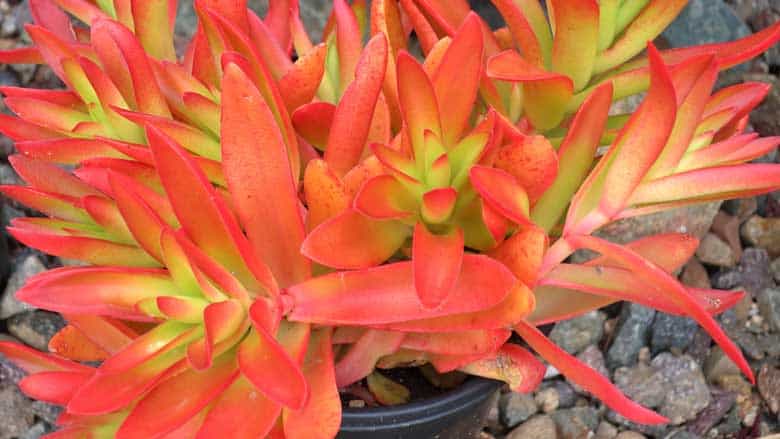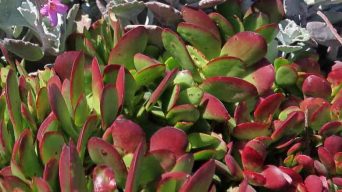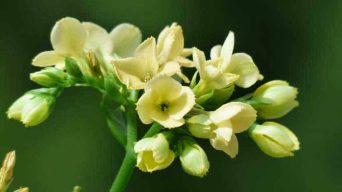The Crassula capitella ‘Campfire Crassula’ is a popular succulent plant because of its beautiful red and orange coloration.
It has been used in many gardens, landscapes, and atriums because it grows well in dry conditions.
However, if you want to keep your Campfire Crassula healthy for years, proper care and propagation techniques will be needed.
This guide will provide you with all the information you need to care for and propagate the Crassula capitella ‘Campfire’ so you can enjoy it in your own home!
Overview
| Family: | Crassulaceae |
| Genus: | Crassula |
| Botanical Name: | Crassula capitella |
| Synonyms: | Crassula capitellata, Purgosea capitellata, Turgosea capitella |
| Common Names: | Campfire Plant, Red Flames, Red Pagoda or Saint Andrew’s Cross |
| Origin: | South Africa |
| USDA Hardiness Zones: | 9 – 12 |
| Size: | 6 inches (15 cm) tall and up to 3 feet (90 cm) wide |
| Sun Exposure: | Full sun to partial shade |
| Water Needs: | Water thoroughly but infrequently |
| Soil Type: | Well-draining soil |
| Temperature: | 30°F to 50°F (-1.1°-10 °C) |
| Humidity Levels: | 40-60% |
The Crassula capitella, commonly known as Campfire Crassula, is a perennial succulent in the Crassulaceae family native to South Africa.
This succulent plant has pointed, fleshy leaves with a light green color that turns yellow and bright red when exposed to full sun.
The Campfire Crassula is a succulent plant that can grow up to six inches (15 cm) tall and grows up to three feet (90 cm) wide.
Clusters of white flowers appear in summer.
The Crassula capitella ‘Campfire’ succulent plant flowers in the summer months, displaying clusters of white flowers.
How To Care for Crassula Capitella’ Campfire Crassula’
Crassula Capitella’ Campfire’ care is similar to the care of other Crassula plants.
The following are the main points to provide proper care for a Campfire Crassula succulent.
Sun Exposure & Light Requirements
Crassula Campfire should either be grown in full sun or partial shade.
When grown outdoors, they need to be planted in a location that allows them to get at least 6 hours of sunlight.
They should be in a room with plenty of natural sunlight if grown indoors.
They should be placed near a southern-facing window where they get the most light possible.
Watering Requirements
Crassula Capitella ‘Campfire’ succulents grow well in dry, sandy soils with sparse watering.
The soil should completely dry out before watering the pot again.
The plants will be able to withstand periods of drought and low levels of rainfall during the summer months without showing any signs of distress or damage.
If you notice the succulent leaves exhibiting a downward curl, a change in color to red or brown, and ultimately falling off, it could be a sign of overwatering.
To avoid overwatering, keep an eye on how wet your potting mix feels when squeezed with two fingers.
If water comes out more than a few drops, wait until the top inch has dried before adding more water. Otherwise, skip a watering cycle or give less water each time (even every other week).
Soil Requirements
Crassula capitella ‘Campfire Crassula’ plants like to be kept in well-drained soil and don’t stay wet for too long.
If you’re using a potting mixture as soil, add sand. It will help crassula capitella plants with extra drainage and won’t stay wet for too long.
However, a cactus mix is better for Crassula Campfire plants.
A cactus/succulent soil mix (or a mixture of sand and perlite) is better than traditional potting mixes because they don’t retain as much moisture.
There’s less chance of over or underwatering, which can cause rotting roots or fungus problems.
Temperature and Humidity
The ideal temperature for the Crassula capitella ‘Campfire Crassula’ is between 30°F (−1.1 °C) to 50°F (+10 °C) degrees. They can handle a little bit below freezing but are not tolerant of frost or cold drafts.
The ideal humidity for the Crassula Campfire is between 40% to 60%.
The plants will take in water through their leaves and stem if it’s too dry inside the home.
Too much moisture, on the other hand, could lead to root rot which is unhealthy for this succulent plant.
Fertilizing
Fertilizers will need to be applied once every few months during the growing season or less often if you grow them outdoors year-round and receive plenty of sunlight.
An organic fertilizer at half-strength every few months is the best way for these plants.
These succulents are not heavy feeders, so you won’t need a full-strength fertilizer every month as other plants might require.
Be careful: if your plant has been outdoors for an extended period and starts losing leaves or turns yellow, apply a weak solution as soon as possible. This will likely stop any further damage to the plant in that area.
The solution will need to be reapplied every week or two if the plant is in a location where it doesn’t receive much direct sunlight.
Potting and Repotting
Crassula Capitella ‘Campfire’ is a succulent plant that does not require frequent potting and repotting.
The roots are deep, so the plant can usually be left in its original container for up to two years.
If it becomes too rootbound, it may need an additional one or two inches of soil and some leaf cuttings from outside the growing area’s plants.
When planting this species into a new container, keep drainage holes open because they grow best when their roots have access to moisture without standing in water.
Pruning
Crassula capitella ‘Campfire Crassula’ plants are usually short and grow in clumps. Unlike most Crassulas, this plant does not like to be pruned severely or often at all.
To prevent the legginess of the plant, it should only be trimmed when necessary.
Trimming is needed more frequently if you want a bushy small shrub-like hedge than if grown as a tall ground cover.
- Cut the top off a branch when trimming and leave it with one node at the end. This will encourage branching out from that node.
- Cut away dead or dying growth by pruning them back to the nearest living leaf buds on vines. You can also remove entire branches, but be sure not to overdo this, as it might cause legginess in your plant’s appearance.
Pests and Diseases
The Campfire Crassula succulent plant is relatively pest-free.
One thing to watch out for is mealybugs.
Mealybugs are the most common pest on succulent plants. They are all white with a cottony or woolly texture.
Watch out for them on the underside of leaves, stem joints, and near spots where water accumulates.
Removing any mealybugs you find as soon as possible is essential because they can spread quickly over the plant’s surface area if left unchecked.
Wipe down plants regularly using rubbing alcohol or insecticidal soap to kill off adults before they lay eggs which hatch into larvae that eat succulent parts and produce more mealybugs.
The Crassula Campfire can also be affected by a fungal disease.
Look out for fungus symptoms such as wilting, spots, or yellowing.
If the plant is infected with fungi, it must be treated by dipping it in an anti-fungal solution at least once per week for about three weeks.
The fungus can also spread quickly, so you should immediately check nearby plants and discard any affected ones.
How to Care for Campfire Crassula in Winter
The Crassula capitella ‘Campfire Crassula’ is not a cold-hardy plant, so it’s best to keep it indoors in winter.
- Place your Campfire Crassula where it will get sufficient light but not direct sunlight, which can cause sunburn and leaf spot. The ideal spot is a south- or west-facing window.
- Keep your plant away from drafts and heat sources, such as a fireplace or radiator, which can dry out the ambient air in the room too quickly.
- Reduce watering during winter, and make sure the soil stays moist but not wet.
- Keep the Crassula Campfire plant in a pot that drains well to avoid root rot due to overwatering.
- If your plant looks droopy or wilted, wait to water it until the soil dries out completely.
- If you live in a frost-free area, you can keep your plant outdoors in winter, which will reduce the watering needs.
- If you live anywhere colder than 25 degrees Fahrenheit (-32 Celsius) for a sustained period, it’s best to bring a Campfire indoors.
- When new growth begins again in springtime, resume regular care as outlined above.
The most common problem with frost-tender plants like this one are:
- Leaf spotting and sunburn are caused by too much direct sunlight.
- Root rot from overwatering (either because of cold weather conditions or excessively wet soil).
- Brown leaves due to low light levels.
- Wilting leaves on indoor plants from dry air.
How To Propagate Crassula Capitella’ Campfire Crassula’
Crassula Capitella can be propagated by leaf cuttings, stem cuttings, and seeds.
Leaf Cuttings
Leaf cuttings are a way to propagate Crassula Capitella by using one leaf as the propagation material.
To do this, take a leaf cutting from the plant and allow it to be callous for a few days in a dry location where it will not get too much sunlight.
Once the cut is calloused, plant it in potting soil and keep the soil moist until it starts to root.
If the cutting does not start to root in a few weeks, your propagating conditions are likely unsuitable.
The propagation of Crassula Capitella using leaf cuttings can take anywhere from one month up to six months or more for rooting, depending on various environmental factors and plant health.
Some tips include:
- Keep the leaves moist by watering them every week.
- Do not let too much sunlight hit the leaves while they are allowed to callous, as this may cause wilted or dead spots.
- Place the leaf in a potting soil container so the stem is upright and not horizontal.
Crassula campfire propagation using leaves can be successful, provided you keep these tips in mind.
The Crassula Capitella propagates well, making it an excellent choice for indoor or outdoor plants!
Stem Cuttings
Stem cuttings are a way to propagate Crassula Capitella by using one stem as the propagation material.
To do this, take a stem cutting from the plant and allow it to callous for a few days in a dry location where it will not get too much sunlight.
When transplanting the cutting into potting soil, be sure that you leave at least two or three nodes on top of your desired rooting area so that roots can grow down off of them.
Keep moist until rooted, then water regularly when established outdoors.
This propagation method is a great way to grow new Crassula Capitella plants for those who like this succulent’s round, smooth texture!
Seeds
Seed propagation is a standard method of propagating Crassula capitella ‘Campfire’ succulent plants and is the easiest to do.
To have your seeds sprout into strong new plants, they need sunshine with no more than four hours of direct sunlight per day.
They also require well-drained soil mixed with sand to promote drainage.
Plant them about three inches deep in the ground below their parent plant’s rosette or planting pot.
After you cover them up with some dirt, water them down lightly so as not to disturb them from growing deeper roots on their own.
After about two weeks, you should notice sprouts coming out of the ground, and once they are above four inches tall, it is time to transplant them into their own pot.
This will help give your new plant a better chance at surviving in its new surroundings while providing enough room for growth.
Is the Crassula Capitella ‘Campfire’ Toxic?
The Campfire Crassula plant can be toxic to humans and animals.
You should keep this plant out of reach of pets and children.
Final Thoughts
Crassula Campfire care and propagation is a reasonably easy task.
Care for these beautiful plants is not difficult at all, but some attention is needed.
Following the steps in this guide and with patience, you will be on your way to cultivating these plants for yourself!







